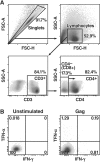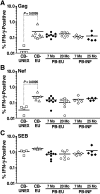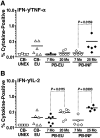Strong HIV-1-specific T cell responses in HIV-1-exposed uninfected infants and neonates revealed after regulatory T cell removal
- PMID: 17183635
- PMCID: PMC1762312
- DOI: 10.1371/journal.pone.0000102
Strong HIV-1-specific T cell responses in HIV-1-exposed uninfected infants and neonates revealed after regulatory T cell removal
Abstract
Background: In utero transmission of HIV-1 occurs on average in only 3%-15% of HIV-1-exposed neonates born to mothers not on antiretroviral drug therapy. Thus, despite potential exposure, the majority of infants remain uninfected. Weak HIV-1-specific T-cell responses have been detected in children exposed to HIV-1, and potentially contribute to protection against infection. We, and others, have recently shown that the removal of CD4(+) CD25(+) T-regulatory (Treg) cells can reveal strong HIV-1 specific T-cell responses in some HIV-1 infected adults. Here, we hypothesized that Treg cells could suppress HIV-1-specific immune responses in young children.
Methodology/principal findings: We studied two cohorts of children. The first group included HIV-1-exposed-uninfected (EU) as well as unexposed (UNEX) neonates. The second group comprised HIV-1-infected and HIV-1-EU children. We quantified the frequency of Treg cells, T-cell activation, and cell-mediated immune responses. We detected high levels of CD4(+) CD25(+) CD127(-) Treg cells and low levels of CD4(+) and CD8(+) T cell activation in the cord blood of the EU neonates. We observed HIV-1-specific T cell immune responses in all of the children exposed to the virus. These T-cell responses were not seen in the cord blood of control HIV-1 unexposed neonates. Moreover, the depletion of CD4(+) CD25(+) Treg cells from the cord blood of EU newborns strikingly augmented both CD4(+) and CD8(+) HIV-1-specific immune responses.
Conclusions/significance: This study provides new evidence that EU infants can mount strong HIV-1-specific T cell responses, and that in utero CD4(+) CD25(+) T-regulatory cells may be contributing to the lack of vertical transmission by reducing T cell activation.
Conflict of interest statement
Figures





References
-
- Magder LS, Mofenson L, Paul ME, Zorrilla CD, Blattner WA, et al. Risk factors for in utero and intrapartum transmission of HIV. J Acquir Immune Defic Syndr. 2005;38:87–95. - PubMed
-
- Connor EM, McSherry G. Immune-based interventions in perinatal human immunodeficiency virus infection. Pediatr Infect Dis J. 1994;13:440–448. - PubMed
-
- Luzuriaga K, Sullivan JL. Pediatric HIV-1 infection: advances and remaining challenges. AIDS Rev. 2002;4:21–26. - PubMed
-
- Mother-to-child transmission of HIV infection in the era of highly active antiretroviral therapy. Clin Infect Dis. 2005;40:458–465. - PubMed
-
- Luzuriaga K, Sullivan JL. Prevention of mother-to-child transmission of HIV infection. Clin Infect Dis. 2005;40:466–467. - PubMed
Publication types
MeSH terms
Substances
Grants and funding
LinkOut - more resources
Full Text Sources
Other Literature Sources
Medical
Research Materials

